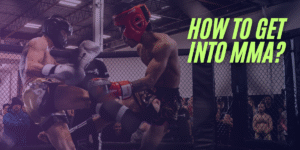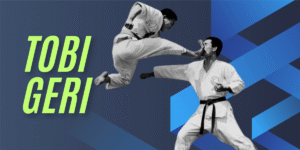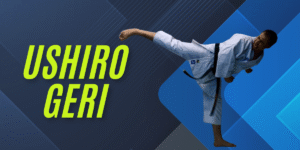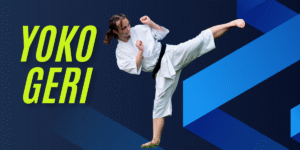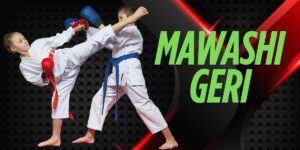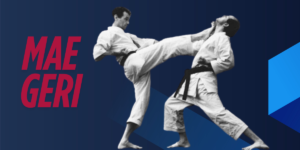Mawashi Geri, also known as the roundhouse kick, is one of the most practiced kicks in karate.
Because of its body dynamics and complexity, Many karateka take years to perfect this technique.
In this guide, I will explain everything you need to know about the Mawashi Geri.
From the basics of executing the kick to advanced training tips and defensive strategies, I’ll walk you through all the steps to help you perfect this key Karate technique.
Understanding The Basics of Mawashi Geri
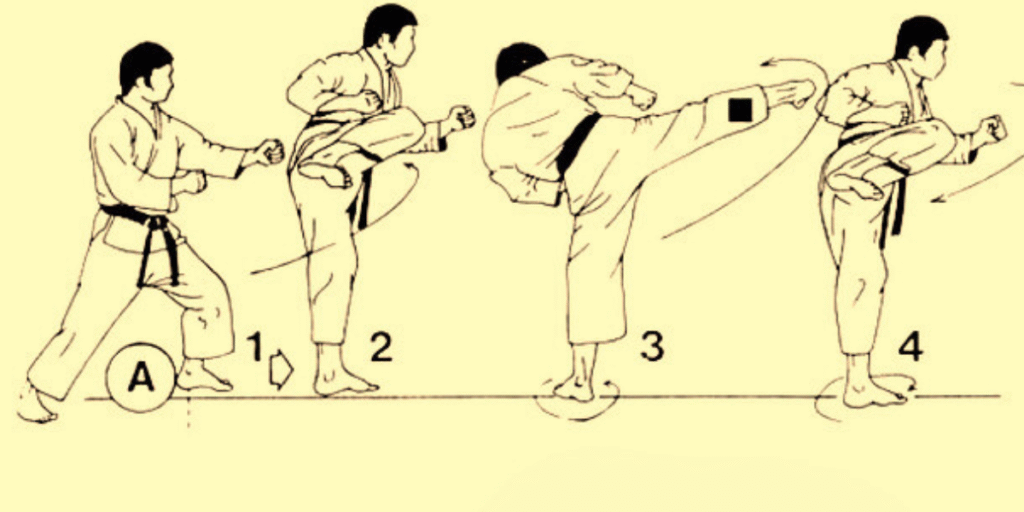
What is Mawashi Geri?
The Japanese name (回し) “Mawashi” means “round,” and “Geri” means “kick,” so it literally translates to “round kick.”
This kick involves swinging your leg in a wide arc and striking with the top of your foot or shin, targeting your opponent’s head, ribs, or torso.
It’s different from other kicks, like a front or side kick, because of the circular motion and how your hip pivots to generate power.
My sensi used to say that Mawashi Geri is a Two-edged sword. Because of hip rotation and leg extension, This kick is super powerful.
However, If you fail to land it properly on your opponent, It will create room for a counterattack.
Mawashi Geri Front Leg vs. Rear Leg
One of the first decisions you’ll make when executing a Mawashi Geri is whether to use your front leg or your rear leg.
Both have advantages and understanding when to use each can make a huge difference in your performance.
Mawashi Geri with the Front Leg
When using the front leg for Mawashi Geri, the kick is quicker and allows for a faster entry. It has both pros and cons.
How to Do It: If you are orthodox-standing with your left foot forward, you have to take your rear/right leg in the position of your left foot and perform the kick with your left foot.
Pros: This is ideal when trying to catch an opponent off guard or in a more defensive stance. The front leg roundhouse kick is generally used to target the opponent’s head or body from a relatively more extended range.
Cons: For beginners and even for some seniors, Performing this kick can be tough, and most of the players are weak with their left foot.
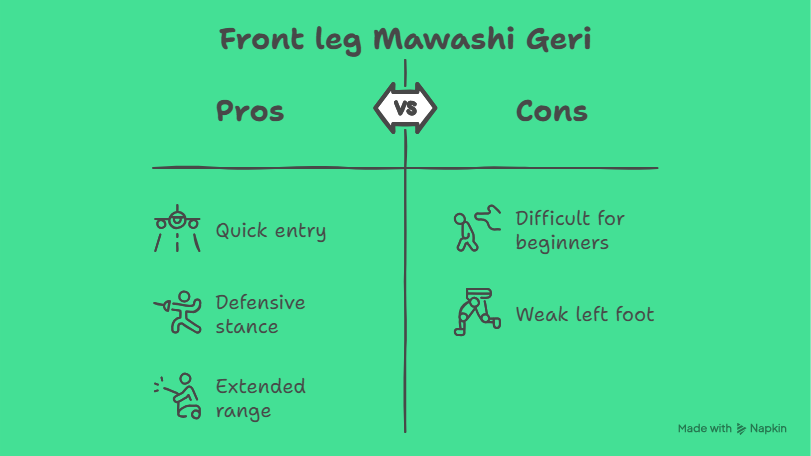
Mawashi Geri with the Rear Leg
The rear leg roundhouse kick, on the other hand, is more powerful. Because it comes naturally to many players, Landing this kick is easier.
How to Do It: It is pretty simple. Whatever your stance is, use your rear leg.
Pros: This version lets you rotate your hips more fully, generating more force behind the kick. It’s ideal when you have a little distance between your opponent and want to make a stronger strike.
Cons: It is more effective in a shorter range. So if you are unsure about the range, Then using it can cause overuse of your power and energy.
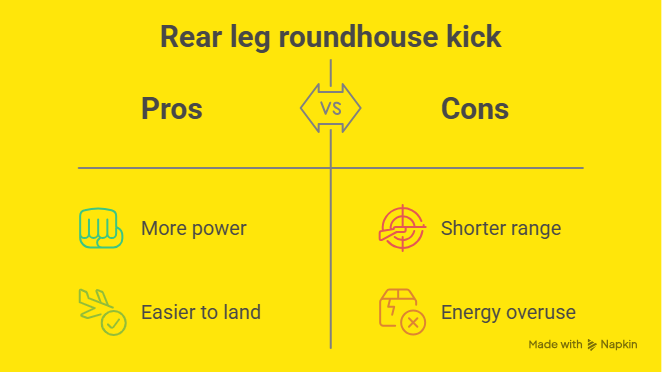
Perfecting Your Mawashi Geri Practice
Training Techniques for Beginners
When you’re just starting out, perfecting your Mawashi Geri can seem like a challenge, but with the right approach, you’ll see improvement in no time.
Here are some key techniques that I have tried and got results fairly quickly:
1. Focus on Foot Placement
One of the most important things to get right is your foot positioning.
Aim to strike with the top of your foot or shin when performing a Mawashi Geri.
Keep your toes pointed slightly downward to ensure you’re using the correct part of your foot for contact.
If your foot is too flat or you kick with the wrong part, it can hurt your foot and reduce the kick’s power.
2. Improve Your Flexibility
No matter which kick you perform, The 1 prerequisite for a kick is your flexibility in hip and leg muscles.
Without flexible legs and hips, you won’t be able to kick high or be as powerful as you want.
To have flexibility, Try to stretch your leg and hip muscles daily. Go to this site, and you will find some easy but effective teaching ideas.
3. Practice the Hip Rotation
Hip Rotation is what makes a mawashi geri powerful and effective. If your hip movement is slow, you must work on it.
To improve your hip rotation, You can do the following:
- Try to stretch your hip regularly.
- start practicing kicking slowly. Do not try to kick high; practice Gedan Mawashi Geri (Low-Level Roundhouse Kick), focusing on hip rotation.
- Never miss your Kihons. These basics are the building blocks for your kicks.
4. Build Balance and Stance
A strong stance is key to performing a good roundhouse kick.
For balance and correct stance, Focus on kihon. While practicing the basics, try to stay as low as possible so your head level doesn’t rise.
This way, your leg muscles will be stronger, and kicks will be powerful.
Mawashi Geri Training: Advanced Tips
Here are some tips for for karateka’s who are above blue belt:
1. Speed and Timing
Speed is crucial when executing a Mawashi Geri, especially if you want to use it in kumite (sparring).
Practice with a partner or on a moving target like a bag to improve your speed.
I used to throw 150 kicks per day for one leg. At first, my legs, back, and glutes were shattered, but with time, it got easier.
For speed and timing, you need to practice more. The more you do it, the more accurate it will be.
2. Distance and Footwork
A key part of Mawashi Geri is the distance between you and your opponent.
Advanced practitioners use footwork and timing to close the gap and set up the perfect strike.
When you’re too far away, you might miss or lack power. When you’re too close, your kick might lose accuracy.
3. Kicking at Different Angles
The difference between a black belt and a brown belt in landing Mawashi Geri is the use of angle.
In an actual sparring match, the angle at which you kick can determine whether your strike lands cleanly or not. When sparring, be agile and use both legs to manipulate the angles.
4. Integrating the Kick with Other Techniques
Mawashi Geri doesn’t always have to be the main move; it can be used to set up or follow up with other strikes. You can use it after a jab or a block or combine it with punches or other kicks.
Mawashi Geri in Kumite
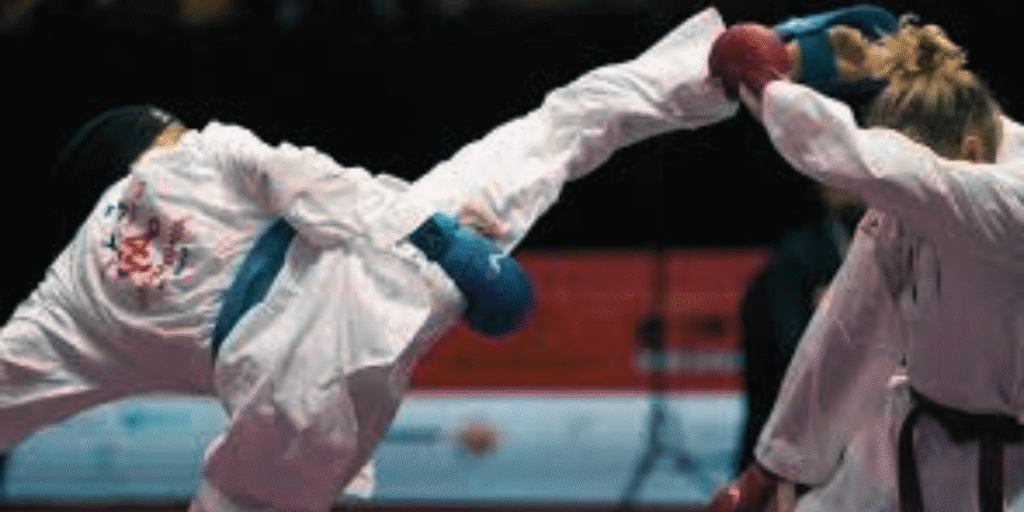
Practicing Mawashi Geri in sparring or Kata’s is one thing, But incorporating it into your Kumite arsenal is tough.
Here are some insights that might help you to use Mawashi Geri as both an offensive and defensive tool for Kumite
Using Mawashi Geri for Offense in Sparring
1. Catching Your Opponent Off Guard
A well-executed Mawashi Geri can be a powerful surprise attack, especially when your opponent expects a different move.
To set up this surprise kick, you can throw a jab or a feint to distract your opponent. As soon as they react, throw the Mawashi Geri. Even if you fail to land correctly, Believe me, the opponent will feel the power and will become hesitant.
2. Targeting the Head or Body
The Mawashi Geri is highly effective at targeting the head or body. You must get the right angle and height on your kick to land it on the head.
In Kumite, a high roundhouse kick can score 3 precious points by landing cleanly to the head. In contrast, a body-level kick can break defenses or cause your opponent to lose balance.
3. Using It to Set Up Other Techniques
Mawashi Geri is great for creating openings for other attacks. For example, you might follow up with a punch or another kick after landing a roundhouse kick.
Once you’ve created an opening with the Mawashi Geri, you’ll have the upper hand in continuing your offense.
You can also use it to push your opponent back and control the distance. After landing a solid Mawashi Geri, you can quickly retreat, reassess the situation, and look for other opportunities to strike.
Guillotine choke: Grip and hand position
The mechanics of the guillotine choke mostly depend on the grip and hand position of the attacker. There are two distinct ways you can grip and perform a guillotine choke.
- High Elbow position
- Hight wrist position
A high elbow position means your elbow will be high and over the shoulder of your opponent.
When you place your right hand under the neck of your partner, your left hand will connect with your right hand. In a high elbow grip, you use your left hand to pull your right hand up towards your face.
By doing that your left elbow will move upward. This upward left elbow can be used to control the opponent’s shoulder and his counterattack.
In the high wrist position, what players do is twist the wrist and create extra force. Players like Gordon Ryan used this type of guillotine choke.
Defending Against Mawashi Geri
Now, let’s talk about how to defend yourself from Mawashi Geri:
1. The Correct Stance and Guard
Defending against Mawashi Geri starts with a solid stance and guard.
Always keep moving or jumping so your body takes less time to react. If you’re a strong guard, you can block or evade the kick more easily. Staying light on your feet and ready to move quickly is essential.
2. Blocking the Kick
When the Mawashi Geri comes toward you, your first instinct might be to raise your arm or leg to block it.
Thats why you need to keep your guard up while sparring. While sparring, I used to drop my guard, and I learned it with a Bloddy(!) price.
To properly block the roundhouse kick, lift your lead arm to protect your head or ribs, using your forearm to deflect the kick.
Raise your knee to protect yourself from a lower kick aimed at your torso, creating a shield with your leg.
3. Evasion and Sidestepping
Another effective way to defend against the Mawashi Geri is by evading it entirely.
This technique is not only for defending Mawashi Geri but for all attacks.
When your opponent throws the kick, you can sidestep, stepping to your left or right to avoid the impact.
This allows you to stay out of range and puts you in a better position to counterattack.
For practicing, keep practicing evading while sparring. For effective sidesteps, you need strong legs and core. Try to train these muscles every day.
4. Countering the Kick
The best way of countering a Mawashi Geri is a Zuki. Gyako Zuki or Ot Zuki. It’s best against a Roundhouse kick.
Once you’ve blocked or evaded the kick, you can quickly close the gap and deliver your strike.
Common Mistakes to Avoid with Mawashi Geri
When it comes to Mawashi Geri, Even senior players make mistakes. Here are a few key areas to focus on:
1. Incorrect Foot Placement
Many made the mistake of kicking with the toe rather than Shin when delivering a kick.
When you kick, your foot touches your shin and keeps your toes slightly downward.
Avoid kicking with a flat foot or the bottom of your foot, as this will decrease the strike’s power and increase the chance of injury.
2. Lack of Hip Rotation
The power of the Mawashi Geri comes from the hip rotation. A common mistake for beginners (and even some advanced practitioners) is not rotating the hip enough during the kick.
How will you know that you are rotating your hips? While kicking, your Base foot (on which you are standing) will rotate slightly.
If this is not happening, you are doing it wrong.
3. Overextending the Kick
Another mistake leading to a weaker Mawashi Geri is overextending your leg.
If you kick too far out, you risk losing balance and being unable to follow up with another technique.
Overextension can lead to a counter from your opponent.
4. Not Engaging Your Core
Your core muscles play a significant role in the Mawashi Geri, and failing to engage them can lead to a weaker, less controlled kick.
Your core helps stabilize your body, allowing you to kick with more balance and strength.
Final Thoughts
As a karateka, Mawashi Geri is a crucial weapon to have. Whether in Kumite, Kata or self-defense, Nothing is comparable to this attack.
But mastering it requires guided effort, and you must focus on many areas before even trying to land it on an opponent.
This guide will help you with your journey to improving this beautiful kick.
So, whether you’re just getting started or looking to refine your technique, take the time to perfect this iconic Karate move.
Trust me, once you’ve got it down, you’ll feel more confident in your skills and ready for whatever challenge comes your way.
You Might Also Like




